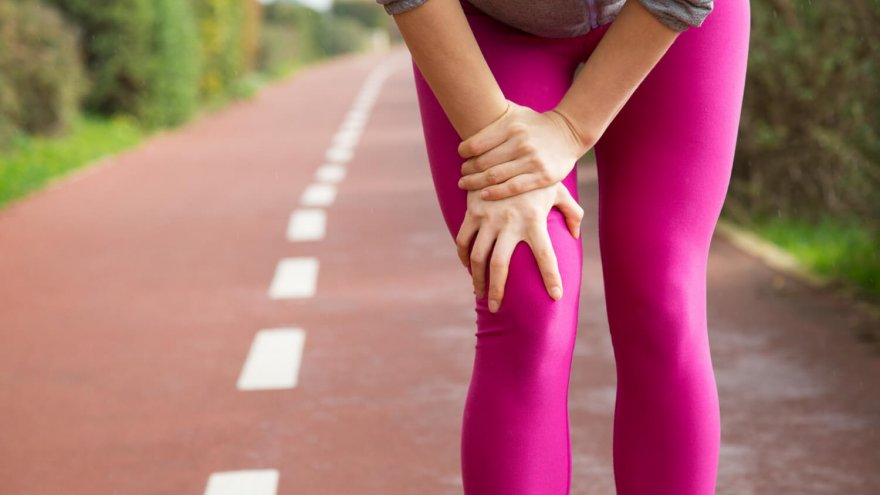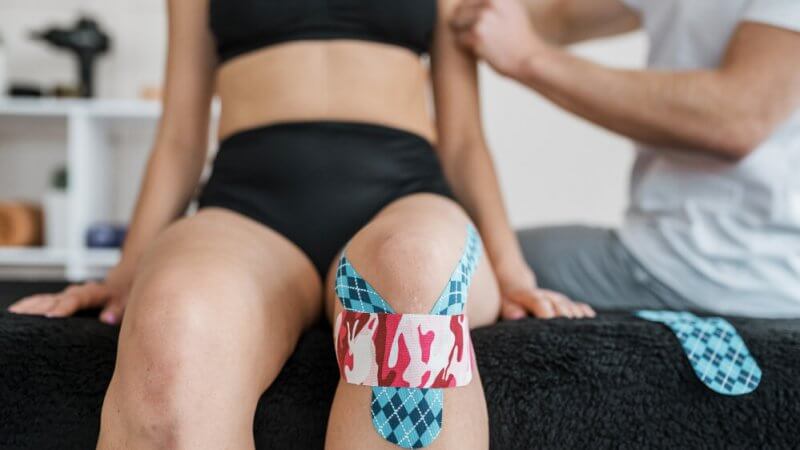Running With Pain Behind the Knee: Causes, Treatment & Prevention

Runners often experience various types of pain, discomfort, or body aches. How do you know when you should be concerned, and what is normal discomfort?
If you have grappled with knee pain, you know how challenging that can be. Most runners think about pain in the front or side of the knee when asked about common knee injuries.
But what about a sharp pain that is in the back of the knee?
Posterior Knee Pain: 7 Common Causes
There are many possible causes of pain at the back of your knee.
- Cartilage Tear: This injury can result from a fall or twisting of the knee, but it can also occur from normal use and wear and tear that happens as runners log more miles.
- Knee Sprain: One of the reasons runners need to be so cognizant of the surface and terrain being run upon is the danger of stepping into a hole or tripping on something, which can cause the knee to twist. This can result in a sprain or dislocation of the knee.
- Hyperextension: If a knee joint bends too far in the wrong direction, joint pain and hyperextension can happen. Resulting instability can happen from this type of injury. Hyperextension is most common in activities that involve cutting and frequent starting and stopping.
- Osteoarthritis: A degenerative condition that often happens as an athlete ages, osteoarthritis can cause pain at the back of your knee. While it can also occur based on injury or overuse, it is most commonly seen in athletes over 50.
- Baker’s Cyst (popliteal cyst): When fluid leaks out of the joint, a lump or buildup can occur. This cyst can put pressure on nerves and muscles, which can result in severe pain.
- Bursitis: When a bursa sac gets inflamed, it results in a dull pain in your knee area. Bursitis is a common issue around major joints and occurs with age. It can also be the result of psoriatic arthritis and rheumatoid arthritis.
- Other Common Type Injuries: Sometimes the pain in the knee is a sign of a problem somewhere else on your body. A hamstring injury, for example, can cause you to favor the pain, which displaces the discomfort from the hamstring muscles to the knee. Pay attention to your entire body when trying to determine where a problem originates.
Can You Pull A Muscle Behind Your Knee?
You sure can. The knee is a very complicated system of muscles, ligaments, and bone. It makes sense that something could go awry.
A knee strain means the muscle or tendon has been stretched or torn.
A sprain, on the other hand, is when the ligaments in the knee joint are out of whack, causing ligament injuries.
How Do You Treat A Pulled Muscle Behind The Knee?
Symptoms of a pulled muscle include limited range of motion, swelling, aching, pain, along with possible bruising. You can start out with the suggestions above.
You know the drill: rest, elevate, ibuprofen or other anti-inflammatory medicines, ice… baby it a little.

How do you know if you need to seek orthopedic or medical advice? If it gets worse instead of better. If you find yourself unable to walk or do everyday tasks. If the swelling increases.
If you try ice, rest, and elevation and it feels well enough to walk around at work, etc., but not good enough to run, give it another day or two and stay the course.
If those home remedies do not give you any relief, you may need to see a professional.
How Do You Treat Tendon Pain Behind The Knee?
You may not know if your pain is from a muscle pull or tendon (patellar tendonitis). You treat tendon pain much like muscle pain, as detailed above.
A compression bandage can also prove helpful if you have muscle or tendon pain.
How Do You Fix The Pain Behind Your Knee?
If you have knee problems, you may need to rest it. A few days off might be just what the doctor ordered.
In addition, the standard treatment of RICE (rest, ice, compression, and elevation) could prove helpful.
If you are looking for great, reusable ways to ice your sore body, check out these ice pack suggestions! A flexible ice pack is crucial on a part of the body such as the knee.
Over-the-counter medications like ibuprofen can help you cut down on the inflammation inside the knee and help with pain management. Compression on the knee can be achieved through the use of an ace-type bandage or knee sleeve of some type.
Often, doing some physical therapy can help with an injury. You can find yourself a health care professional to help you out, which is sometimes the best bet.
However, you can find all sorts of excellent stretches online as the first line of defense.
Knee Injury Prevention
Once you have alleviated the pain in your lower leg and are back in the game, ask yourself if you should strengthen your muscles so that you don’t need to worry about suffering from knee pain again. It could be that you have weaknesses that some strength training can help take care of.
Working on your flexibility is another great preventative measure. The fact is, most distance runners could benefit from some growth in this department.

A good warm-up is another great tool to have in your toolkit. Many people do not adequately warm-up which can cause problems and lead to injury. Warm-up and cool-down are not things to skimp on.
Easing into any new activity is also important. It can be tempting to jump right into things, but that usually is not the best course of action.
Just like we follow the 10% rule when increasing our weekly mileage, we should not dive headfirst into any type of training. Give your body some time to adjust.
Did you know that there are some shoes that are better than others for protecting your bad knees? Check out the 7 Best Shoes for Bad Knees.
Lastly, some people find that wearing a knee brace of some sort is helpful to address knee pain. If you are resuming activity, you may find using this type of support can help you.
Being Proactive Helps
I guess that when push comes to shove it is important to remember that a pain in the knee does not have to become a pain in other areas of the body.
There are things to do to help prevent knee pain, as well as tactics to help rehabilitate a bum knee.
If you are experiencing knee pain, get proactive. You can be back on track before you know it.
Sources
- , Why am I getting pain… at the back of my knee?, Orthopaedic Clinic
Latest Articles
 Is Running on a Treadmill Easier Than Running Outside?Runners have their own preferences, whether it is treadmill running, running outside on the road, or exploring trails. So...
Is Running on a Treadmill Easier Than Running Outside?Runners have their own preferences, whether it is treadmill running, running outside on the road, or exploring trails. So... Is It OK to Use Trail Running Shoes on the Road?While trail running shoes can be used on roads, especially in situations where a runner encounters mixed terrains or pref...
Is It OK to Use Trail Running Shoes on the Road?While trail running shoes can be used on roads, especially in situations where a runner encounters mixed terrains or pref... How to Fix Sore Quads After Running?Rest, ice, gentle stretching, and over-the-counter pain relievers can help soothe sore quads after running. Also, ensure ...
How to Fix Sore Quads After Running?Rest, ice, gentle stretching, and over-the-counter pain relievers can help soothe sore quads after running. Also, ensure ... 10 Fruits With The Most Electrolytes to Replace Sports DrinksThese fruits are high in electrolytes such as potassium, magnesium, and calcium, essential for hydration, muscle function...
10 Fruits With The Most Electrolytes to Replace Sports DrinksThese fruits are high in electrolytes such as potassium, magnesium, and calcium, essential for hydration, muscle function...

